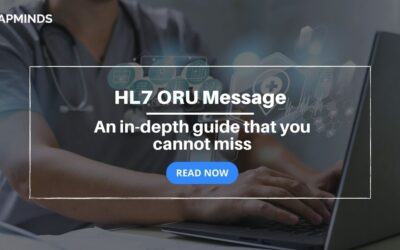A Step By Step Guide To HL7 FHIR For Developers
In today’s healthcare industry everyone is looking for a smarter and safer way for healthcare information exchange. And this has been a primary goal for all healthcare providers. This quick data exchange is not only crucial for healthcare providers, but it’s also necessary for software developers and IT professionals tasked with integrating software applications. New to FHIR? Then, this article is for you. We have put together the basics of FHIR and the implementation concepts with a step by step to step guide to dig deeper into FHIR.
What is FHIR and why it is so popular?
FHIR (Fast Healthcare Interoperability Resources) is a standard for exchanging data between healthcare applications in an easier and faster way. The motto of FHIR is to address the emerging digitization of the healthcare industry and the need for patient medical records to be easily available, discoverable, and understandable.
“The scope of FHIR is very broad, covering public health, clinical care, clinical trials, administration, and financial aspects. The HL7 FHIR standard is intended for worldwide use and in a huge variety of architectures and scenarios.”
Health Level 7 (HL7)
Interoperability is a need in the cutting edge clinical practice. It guarantees that patient healthcare data is accessible whenever and wherever it is required, without the need to sit tight for faxes or other more slow types of data transfer methodologies. FHIR could be the enhanced version, to make the usage and sharing of electronic health records easier and more efficient.
How is FHIR different from other interoperability standards?
You may think why FHIR is more advantageous when compared to other interoperability standards like clinical document architecture or the continuity of care record standards. The major difference between the many popular interoperability standards and FHIR is simplicity and flexibility.
What’s special with FHIR? FHIR combines the best features of previous data exchange standards into a common specification while being flexible enough to meet the needs of a wide variety of use cases within the healthcare ecosystem.
Commonly, each application of the HL7 FHIR standard requires a resource approach to the information model such as Medication, Procedure, or Immunization, which is more granular than other standards. Systems can make effective use of those FHIR Resources to then create commonly used content groupings such as lists and documents. FHIR is very flexible and it’s very easy and simple to implement. FHIR focuses on implementation and uses the latest web technologies to aid rapid adoption.
FHIR supports four information exchange methods, including REST, the software architectural style that forms the basis for the World Wide Web. This approach makes FHIR more special when compared to the other Internet development efforts outside of health care.
RELATED:
FHIR: A NEW PATH TOWARDS HEALTHCARE INTEROPERABILITY
ROLE OF FHIR IN INTEROPERABILITY
Benefits Of FHIR For Developers
FHIR permits healthcare data, both clinical and administrative information, to be accessed safely to the individuals who need to access it, and to the individuals who reserve the privilege to do as such to assist a patient receiving care. Additionally, the benefits of FHIR for developers are as follows:
- A solid spotlight on quick and simple execution; developers have reported they encountered straightforward interfaces being implementable in a single day.
- Free to use without any restrictions
- Support from major vendors including Apple, Microsoft, Google, Epic, Cerner, and most other EHR vendors.
- Many free, online, and downloadable tools, including reference servers and implementation libraries.
- Numerous open models accessible to help launch the improvement of new applications.
- Interoperability out-of-the-box – base resources can be used as-is, but can also be adapted for local requirements (the process of Profiling).
- An evolutionary development path from earlier HL7 healthcare standards, Version 2 and Clinical Document Architecture (CDA®), enabling them to co-exist and leverage each other.
- A strong foundation in web standards including XML, JSON, HTTP, and OAuth.
- Compact and easily-understood online specifications.
- For ease of use, FHIR is designed with a human-readable serialization format for developers.
- A worldwide network community to assist implementers.
Guide To FHIR: How it works?
The Healthcare providers of today’s advanced healthcare industry are struggling for secure information exchange and developers struggle to provide ways for them to do it. Not everyone thinks like the same, of course, each individual will have their ideas and they use various methods that may not work out well for others. But FHIR is different from the other methodologies, it works for everyone from hospitals to veterinarians with safety and security.
You may come across the word ‘Resources’ in many places when you try to explore more about FHIR. What are the FHIR resources? How does it connect with the FHIR implementation process? FHIR is built upon the concept of “resources” – the basic units of interoperability which are used as building blocks that can be incorporated in existing systems to resolve the clinical, and administrative problems in healthcare. Resources may aid in exchanging the data or provide a means to store the data like a web page does for the internet.
To keep this process and the structure of resources consistent, resources must include the following key features:
- URL: A URL to identify the resource
- METADATA: Metadata to aid in searches and for cataloging
- XHTML: An XHTML summary so people can read it
- Definitions for data elements
- An extensibility framework specific to healthcare
Resources may get assigned a URL for easy identification. Similar to a web page that may use a relative URL, the URL is not always defined within the resource. If you want copies of the resource to point to the original at all times, adding a URL inside the resource is necessary. However, this may be unnecessary in most cases. You’ll have to make that decision.
You can manipulate data using FHIR’s built-in REST API. You can make use of the functions like POST, DELETE, GET, and PUT to create, read, or else you can simply manage resources. For instance, you could use “PUT https://www.example.com/path-to-your-resource/resource-type/resource-id” to update a resource when the data changes or needs to get changed for whatever reason.
Final Thoughts
FHIR is powerful and may topple the current hierarchy of interoperability in healthcare. Arguably, FHIR is trampling other standards, but it’s hard to get developers and providers to make changes. Once they have a working solution, they tend to stick with that solution. FHIR is a significant improvement over previous and current standards, but the inconsistent implementation of FHIR continues to be a hurdle in the path toward interoperability. CapMinds integration services can make interoperability both practical and cost-effective while eliminating the usual barriers to interoperability.



